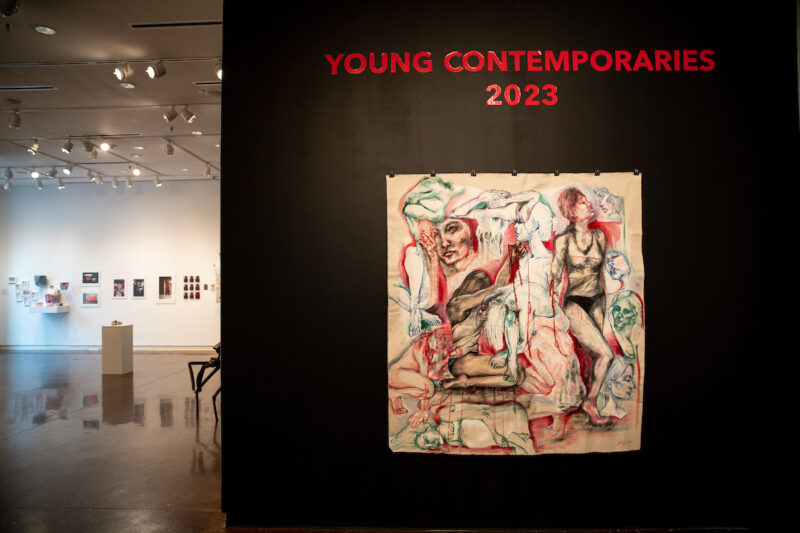Each spring, the directors of the Halsey Institute of Contemporary Art stage a show that exclusively features the artwork of students at the College of Charleston. That show – Young Contemporaries – has been a marquee event for nearly 40 years. This year’s edition featured the work of more than 40 students.
According to Katie Hirsch, the gallery’s director, Young Contemporaries is an important event for the Charleston community. It offers benefits for both the exhibitor and viewer alike.
“I’m consistently impressed by the work submitted for this annual exhibition,” Hirsch says. “This year, we received over 450 separate submissions that were reviewed by a very selective juror (New York City-based artist David Antonio Cruz). It’s interesting that students from all across campus submitted artwork for consideration. Consequently, this show includes not only the work of students from the School of the Arts, but also pieces created by students from a wide array of academic majors, including marketing, biochemistry, psychology, business administration, geology, economics and more. For us, the Young Contemporaries show accomplishes dual objectives in allowing the Halsey Institute of Contemporary Art to showcase the talent of our students and giving students a chance to experience the competitive review process involved in submitting work for a professional exhibition. The energy of this exhibition is like no other.”
Studio art major Thomas Hicks ’25 had several pieces accepted for the exhibit, and one, a fabric-based hanging entitled “Cinders,” won the Norton M. Seltzer Prize.
“I started o ut as a photographer,” says the recipient of the Rick Watkins Endowed Memorial Scholarship Fund, “and I still work in that medium, but I’ve evolved a strong interest in fabrics and texture. Before the show, I was really intent on winning a prize and getting recognition for my work, so, I put particular energy into that.
ut as a photographer,” says the recipient of the Rick Watkins Endowed Memorial Scholarship Fund, “and I still work in that medium, but I’ve evolved a strong interest in fabrics and texture. Before the show, I was really intent on winning a prize and getting recognition for my work, so, I put particular energy into that.
“Cinders,” he continues “represents a process for me as an artist. I’m really interested in knits. I love the tangibility of this medium, so I bought a knitting machine for Christmas. I love the way different yarns react to this machine, and I wanted to explore that through my art making. I used cotton because I like the way it reacts to plaster when it’s dipped. The mixture for this piece was equal parts water, glue and plaster mixed. The glue is used so that the piece can burn easily and the plaster isn’t blocking all the cotton. There’s a complexity to the piece that I think the juror appreciated.”
Grace Womack ’23, a studio art major and art history minor, also had multiple pieces at the exhibition. She won Best Print in the Salon des Refusés and the Karin Jurick Prize for her piece “What You See Is Not All I Am, 2023.”
 “The honor of having your work championed in such a way as what the Halsey Institute and the Department of Studio Art does is truly incredible,” says the recipient of the Janet Simcox Endowed Scholarship. “The confidence the Karin Jurick Prize brings to keep creating and the actual support it provides to continue my practice is invaluable. Of course, I could never stop creating my slightly off-putting truth, but it feels freakin’ great to know that it’s understood and others want more of it.”
“The honor of having your work championed in such a way as what the Halsey Institute and the Department of Studio Art does is truly incredible,” says the recipient of the Janet Simcox Endowed Scholarship. “The confidence the Karin Jurick Prize brings to keep creating and the actual support it provides to continue my practice is invaluable. Of course, I could never stop creating my slightly off-putting truth, but it feels freakin’ great to know that it’s understood and others want more of it.”
Womack’s piece, made of acrylic paint and spray paint on chicken wire, plaster gauze, canvas and plastic, stems from her research on what our human body does to work with our soul. It represents the visualization of her curiosities, remembrances and wishes, but she emphasizes that what the piece conveys is entirely personal to the viewer.
Womack created her piece as a reminder. “While these bodies we inhabit are intricate, autonomous and one of a kind, they are still a vessel. A vessel that is filled with you.
“Too much in this life relies on appearance, when that appearance isn’t the start of what you are,” she continues. “What you see is not the entirety of my past, present and future; all you see is my skin. With this in mind, I sculpted a transformation before your eyes. I painted a skeleton in the front, a face looking up and a bare back. While walking around the sculpture, there is either a growth or a decay depending on which way you look at it. It demonstrates that from only seeing the things you see, you then see what is not me.”
The Young Contemporaries awards are funded by the Dean’s Excellence Fund for the College of Charleston School of the Arts. The Norton M. Seltzer Award, which Hicks received, is funded by Mindelle Seltzer. The Karin Jurick Award, which Womack received, is funded by the Robert Lange Studios community.


